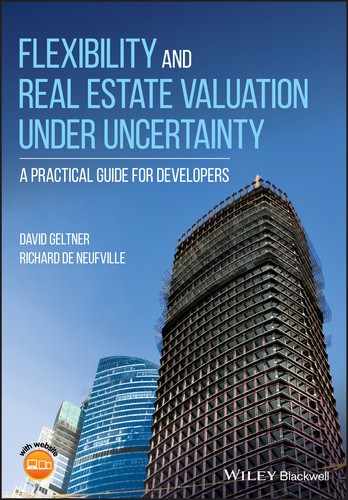18
Project Start‐Delay Flexibility: We Model the Value of the Most Basic and Widely Available Development Project Option
Now that you have seen how our example development project performs under realistic uncertainty without flexibility, it is time to begin to see the effect that flexibility can have. Remember, the real benchmark for judging the effect of flexibility is not the traditional, single‐stream pro forma, but rather the project recognizing uncertainty but without flexibility. This chapter begins a series of five chapters in which we introduce specific types of flexibilities, one at a time, into the simulation model of the investment performance of the Garden City project under uncertainty that we described in the last chapter.
In this chapter and the next, we will focus on the most basic type of flexibility that exists most widely in development—the flexibility to delay the start of project. We use the results of this analysis to gain intuition about the nature of the value that project start‐delay flexibility adds to the project, from an investment perspective.
We will introduce a key feature of the model: the developer’s decision rule regarding how, or when, to trigger the option. We begin to explore the effect of such decision rules in this chapter, and will explore the topic further in the following chapter.
18.1 Project Start‐Delay Option
Chapter 15 presented the option to delay the start of a project at a general level. We noted there that this delay option is an example of the broader concept of production timing options. The overall start‐delay option reflects the fundamental development call option that land ownership entails, as described in Chapter 12. In general, landowners have broad discretion about when, and whether, they choose to start a development project on their land. We provided a very simple numerical example of this option in Section 12.5. That example was overly simplistic, considering only a single period of time and binary scenarios with instantaneous construction. Now, our more realistic Garden City example project and simulation model will allow us to explore this option much more completely and realistically (although still with sufficient abstraction so as not to lose sight of the forest through the trees).
As described in the preceding chapters, we generally view call options as “offensive” options, enabling without mandating the landowner to profit from a favorable circumstance. However, we made the point in Section 12.4 that call options and put options are really two sides of the same coin, and the option “to do” is also the option “to not do.” With this in mind, we noted in Section 15.1 that, in practice, by the time developers have done the necessary preparation work to be able to start a development project, the timing flexibility that exists is typically viewed as a “delay” option, which is essentially a defensive type (put) option. In other words, in practice, developers plan to start the project “right away” unless they choose to exercise their option to postpone starting it.
This is the perspective from which we model the option to delay the start of our Garden City example project. We presume that the developer has completed the preparations for the project, and could start the project immediately as per the base plan schedule—or could elect to postpone the project. We assume that the decision‐maker can consider the current market conditions and decide whether to begin the project in any year—or, alternatively, hold off for another year and reconsider at that point. Once the developer starts the project, it must be completed according to the base plan schedule, without any delay beyond the initial start delay.
Thus, for analytical clarity, the only type of flexibility we consider in this chapter is the option to delay the start of the project. We ignore any other timing or product options. For practical as well as technical modeling reasons, we put an upper limit on the delay at 15 years, after which, if the project still has not been started, we assume that it will be permanently abandoned (for a land resale “salvage value” equal to one‐half the original land purchase price).
18.2 Option Exercise Decision Rule
To specify the option to delay the start of the project, we must program a decision rule into our simulation model. The decision rule specifies the conditions that will trigger the delay option. In other words, in any given scenario, the decision rule will determine in which year the developer will start the project (or, potentially, will abandon it permanently if the project has not been started by Year 15). We can program this decision rule to be almost anything we want it to be (within reason). How shall we think about what it should be?
Formal economic analyses of options model the situation mathematically and attempt to solve for explicit formulas to define the optimal decision rule. However, as noted at the outset of this book, such formal economic models rely on several simplifying assumptions that are unrealistic and overly restrictive for practical application to real estate development projects. (For example, they typically assume that the price dynamics process of the asset market is a pure random walk. While this is a decent approximation for the stock market, it is not very accurate for real estate markets. See Section 7.2.)
We take a different approach in our simulation of the value of flexibility. We allow the asset price dynamics to be much more complex and nuanced (see Section 7.3). And we do not presume optimal or even necessarily rational behavior on the part of the decision‐maker. Rather, we pose an intuitive and likely realistic model of the actual decision‐making process. (The rule we adopt does share with the formal economic models the basic intuition that the decision to delay is based on lack of apparent and sufficient profitability for the project.)
One can model decision rules to exercise options in many ways. Note, however, that we can only properly base decision rules on what has happened; we cannot know the future—see Box 18.1. In the present chapter, we consider what we will call our “Aggressive Developer Rule.” (We will consider a different rule in the following chapter.)
The Aggressive Developer Rule models very optimistic developers who hardly ever delay starting the project. According to this rule, the developer will start the project (that is, doesn’t trigger the delay option) unless all the following three conditions hold:
- The development would be unprofitable at the prices indicated by the current year’s pricing factor realizations; and
- The development would also be unprofitable at the prices indicated by the previous year’s pricing factor realizations; and
- The profitability of the development is less (worse) under the current year’s pricing factor realizations than under the previous year’s pricing factor realizations.
This Aggressive Developer Rule makes it inherently difficult to not start the project. It sets up a bias against delaying the project. The developer holds off on starting the project only if several indicators are “flashing red”—that is, only if the housing market has been sufficiently bad as to depress housing unit sales profitability below the base case for 2 years in a row, and, furthermore, if the market is getting worse.
Such a decision rule might well approximate the behavior of some developers. After all, developers do tend to be an optimistic lot. Furthermore, there can be serious practical and organizational impediments to delaying a project that is ready to start.
18.3 Defining “Profit” in the Decision Model
At this point, it will be worth our while to elaborate briefly on a key aspect of the decision rule to trigger the option. Such rules usually are based on some measure reflecting the profitability of the project at a given time (a potential trigger decision time) within the realized, randomly generated future scenario. The relevant profitability can be measured and implemented in the spreadsheet model in various ways. In a very sophisticated approach, one could program a decision‐maker’s forecast of the future IRR of the project based on current and past realizations in the scenario.
Our philosophy is to lean more toward simplicity. One technique that we employ in this regard is that we measure “profitability” only relative to the base case. That is, we work with the pricing factors, and not directly with the implied money values in the scenario. The scenario money values are simply the money values in the base case multiplied by the pricing factors. If, in a given period, the relevant revenue pricing factor is less than the relevant construction cost pricing factor, then profitability relative to the base case is negative in that period. This is the definition and measure of profitability that we employ to govern the option implementation decision.
This definition of profitability is easy to program from a technical perspective. Perhaps more importantly, it also reflects the principle we first suggested in Section 7.1 when we were introducing pricing factors. We want to defer to the existing knowledge and expertise in the field, about the investment project that we are modeling. We want to build on the knowledge that the principal parties have about the project, as reflected in the pro forma that they have developed. Of course, this pro forma should be unbiased, not in itself inclined toward either optimism or conservatism. Given this, and given that the investor’s pro forma is viewed as representing an economically justified project (as discussed in Chapter 11), we want to benchmark the relevant definition of “profitability” on that pro forma, just as we want the pricing factors to have a zero‐mean probability distribution (mean ratio of 1.0).
18.4 Value of Start‐Delay Flexibility in the Garden City Project
Now let’s explore the effects of start‐delay flexibility in our example Garden City development project with the Aggressive Developer Rule. Our perspective, as always, is primarily that of the investor in the project. How does this type of flexibility affect the expected value and returns for the project, as well as its risk from an investment perspective?
Of course, the results of our analysis apply only to our specific Garden City example project. Our main purpose is to demonstrate a methodology and a perspective, not to derive fully general conclusions. However, we have constructed the Garden City example to be a typical multi‐asset development project. The numbers in it are typical, and the simulated price dynamics reflect typical real estate market dynamics. The results of our analysis should, therefore, be suggestive for many such projects, particularly at a broad‐brush and qualitative level. This makes them interesting beyond only demonstrating an analysis methodology.
In this section, we compare the simulated investment results of the Garden City project with start‐delay flexibility versus without flexibility (the latter essentially being the benchmark we presented and discussed in Chapter 17). The comparison is always made on the same simulated future realized scenarios. We compare the results with those of the inflexible development plan. Both analyses are otherwise similar. They assume the 18% hurdle discount rate and the $200 M land price.
Figures 18.1–18.4 compare the target curve results for the two cases, in terms of cumulative and frequency outcome distributions, for the NPV and IRR performance metrics. Notice that the delay option adds some value, even though the Aggressive Developer Rule is biased toward not delaying the project. Specifically, this delay option increases the:
- Mean ex‐post NPV of the project by about $8 M (from approximately $25 M in the inflexible base case to approximately $33 M). This is 4% of the $200 M land price. This is worthwhile, as the expected NPV is a metric that is arguably quite relevant for evaluating the land.
- Mean ex‐post IRR by about 175 basis points, from under 20% to over 21%. (A “basis point” is one‐hundredth of a percent, a common unit in the investment industry for referring to returns and especially to “spreads,” or differences between two returns.) Yet, the standard deviation of the simulated IRR falls slightly from about 24% to under 23%. Thus, the expected return is increased, and its risk is decreased.
- These results suggest that, even with strong bias against exercising the option, the flexibility to delay the start of the project makes it somewhat more appealing from an investment risk/return perspective, holding the land price constant.

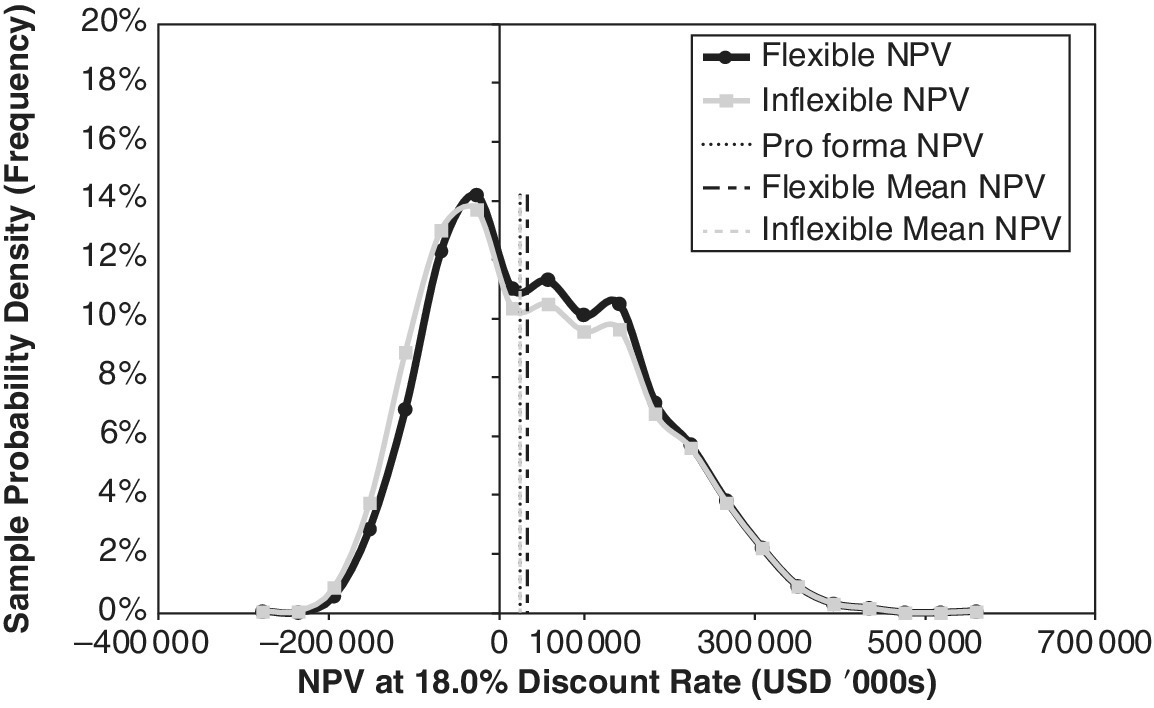
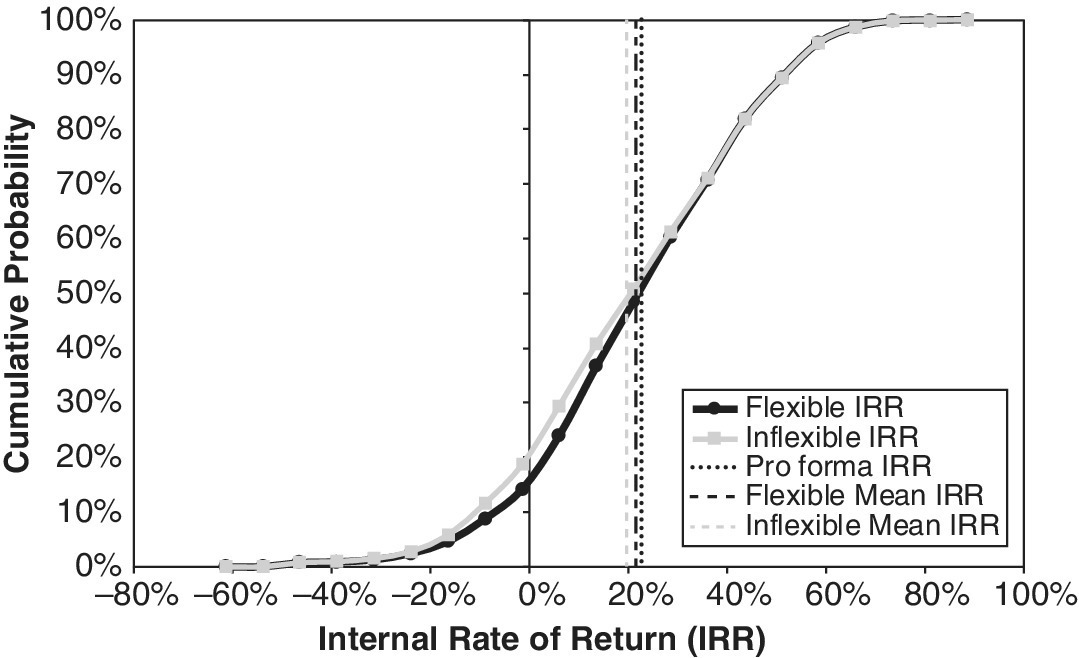
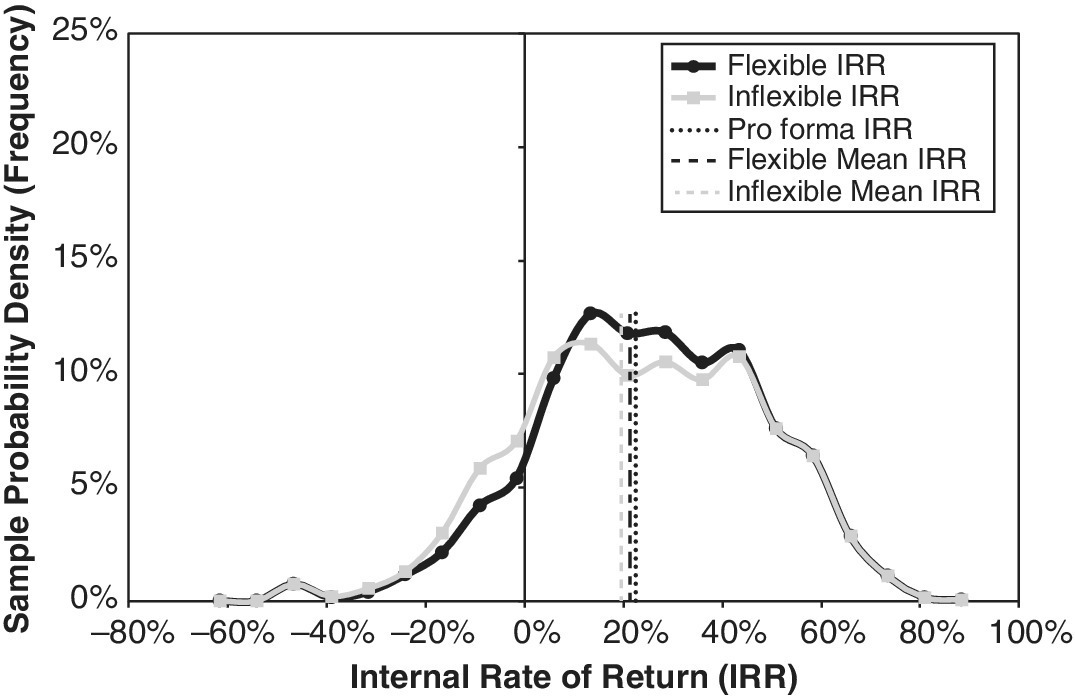
It is important to note how the start‐delay option adds value to the project. Observe that the target curve graphs for the delay option exhibit a rightward shift relative to those for the inflexible plan. Importantly, this rightward shift occurs over the left‐hand tails of the distributions—that is, over the more downside project outcomes. This is the classical signature of a defensive or “put” option that reduces downside risks.
We can also note that, even with the Aggressive Developer Rule, flexibility to delay not only increases value on average, but also is better than the inflexible plan significantly often. The scatterplot in Figure 18.5 illustrates this. It shows, for each of the 2000 trials in the simulation, the difference in the realized IRR achieved by the flexible minus the inflexible model, as a function of the IRR outcome without flexibility. In this case:
- Dots above the horizontal axis are scenarios in which the project with start‐delay flexibility yielded a higher IRR than it would have (in the same scenario) without flexibility.
- Conversely, dots below the axis are scenarios where the start‐delay flexibility resulted in a worse outcome.
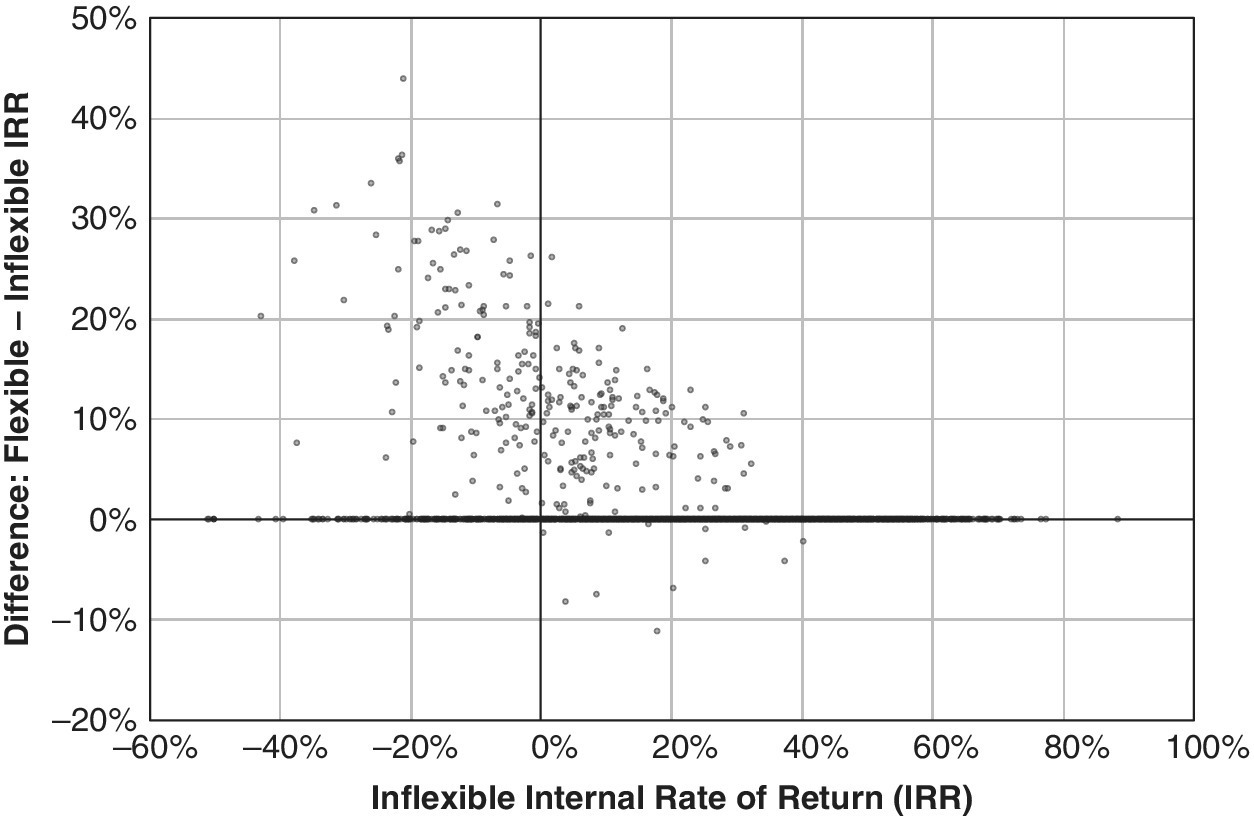
Figure 18.5 Scatterplot of IRR outcomes for start‐delay flexibility (Aggressive Developer Rule).
This scatterplot vividly illustrates that the aggressive flexible plan performs better than the inflexible plan:
- Most significantly, when the project performs poorly, as indicated by dots to the left of the vertical axis, the flexible plan performs better than the inflexible plan. This reinforces the concept of the delay flexibility as a form of insurance, as a put option.
- Only about 10 dots are below the horizontal line, indicating that the inflexible plan is better less than 1% of the time.
For the record, but not obviously from the scatterplot, the flexible and inflexible plans lead to the same results in 85% of the cases—the dots that are on the horizontal line. As with most forms of insurance, the delay option is valuable, but we do not often invoke it. The “aggressive developer” rarely delays starting the project.
18.5 Conclusion
This chapter demonstrated how we can use simulation to model and value flexibility realistically and quantitatively in a typical development project.
We focused on the most basic and common type of flexibility, to time the start of a project, which in practice is a delay option. We explored how this option adds value, even when the developer is predisposed (or under strong pressure) to not delay the start of the project. We observed graphically how the start‐delay option truncates the downside tail of the outcome distributions of investment performance; it simultaneously increases expected returns and reduces risk.
We also introduced the modeling of decision rules for exercising options. This chapter explored a particular decision rule, which we labeled our “Aggressive Developer Rule.” With this rule, the project is only rarely delayed, and the flexibility to delay the project accordingly only adds a small amount of value—less than 5% of the land value. But this is $8 M in the case of the Garden City project, and an extra 175 basis points in the investment’s expected IRR. Furthermore, the way that the option adds value—by improving the downside, providing a type of “insurance”—can be quite valuable to many investors.
The Aggressive Developer Rule is only one possible decision rule for implementing the option to delay the project start. And this option is so basic and widely available that we will explore it further in the next chapter.
